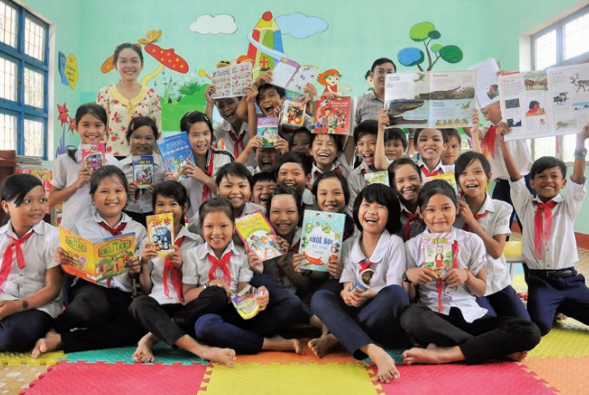In many countries around the world, children are struggling to learn to read. While there are many factors affecting this, such as overcrowded classrooms and lack of teacher training, one of the most significant obstacles is the lack of access to reading books with which to practice reading skills and learn new words. Schools and parents alike are not getting books in childrens’ hands, creating a clear gap. So, why is there a book gap, and whose responsibility is it? With stretched education budgets for governments and families, where is the book budget best used?
While funding textbooks is understood as an obligation of the government, many countries around the world allot little to no funding to acquiring reading materials for students to use in schools or at home. When reading books are funded, they are typically prioritized for secondary level students. Part of this is likely because instruction in secondary grades is typically in English, French, or other global languages that have more available affordable book titles, but also because older students read more complicated texts (such as literary “classics”) that are understood to be necessary in the upper grades. There is a lack of understanding of the need for reading materials with younger children and lack of consensus on how many books should be provided in classroom libraries for students.
However, research shows that investments in books for the youngest learners in the early stages of reading may bring a bigger payoff long-term. Many countries would likely see improved reading scores and better learning outcomes across all grades if investments were made in reading book access for early grades. Books are relatively low-cost compared to other education improvement programs like teacher training or technology initiatives, and data shows they may be the most cost-effective means to improve learning outcomes in schools. Here’s what we know:
Reading books is vital to developing literacy, and literacy is crucial to learning other skills and subjects later in school. Researchers have found that children who grew up without books in the home received on average 3.2 fewer years of education than children with a few dozen books at home. One study from Tanzania found that student literacy scores increased up to 10% when a library was present in their school. Additionally, there is evidence that access to reading books had the biggest impact on students who had fewer other resources available, such as students who lived in rural areas, in poverty, or whose parents lacked education. This data suggests that access to reading materials in school and at home is crucial to literacy acquisition.
The critical link between books and literacy is not widely recognized in many communities, which contributes to difficulty in acquiring and encouraging the use of reading books at home and in school. Many parents were not taught to read and may not understand the importance of reading practice. Additionally, many governments do not recognize the importance of providing reading books in addition to textbooks, and both of these issues contribute to under-emphasis on purchasing reading books in primary grades. For rural and/or low-resource areas, lack of access to and the price of books also contribute to the lack of reading books available to students at home. However, while reading books may not be in the budget for some families, for schools purchasing such books is a relatively inexpensive way to produce large literacy gains. Reading books have been called one of the most cost-effective investments to raise learning outcomes, and investment in library books has been shown to improve reading outcomes in Tanzania, the Philippines, and Rwanda. One notable example is from the Philippines, where the Department of Education created a network of community library hubs, each aiming to have 40 reading books per student. The program has seen high demand for books and high rates of book sharing and has resulted in significant improvement of children’s reading scores and a decline in non-readers.
Books are most helpful in early grades. The reason for this is that children encounter fewer new words and patterns with each successive book over time, meaning that a student in secondary education who has acquired reading skills and an extensive vocabulary will encounter fewer new words in a novel than a kindergartener will in a simple decodable. In other words, books play a crucial role in building vocabulary for young children, and vocabulary is a major building block for lifelong literacy.
The data is clear - ensuring access to books improves literacy and is one of the most cost-effective ways to improve students’ performance in the classroom and beyond. Young learners, whose reading books are typically funded last or not at all, seem to actually be the group which needs them most to see acquisition gains in literacy, and countries who prioritize closing the book gap for early readers have seen significant growth in their reading scores. Investing in books for our youngest students is simply the logical next step in our journey to a more literate global community.
Guest author: Aidan Thomason
References
Evans, M. D. R., Kelley, J., Sikora, J., and Treiman, D. (2010). Family scholarly culture and educational success: Books and schooling in 27 nations. Research in Social Stratification and Mobility. Retrieved from https://www.researchgate.net/publication/222420184_Family_scholarly_culture_and_educational_success_Books_and_schooling_in_27_nations
Global Book Fund Feasibility Study (2016). Retrieved from https://static1.squarespace.com/static/5cb1f6beaadd34703fcc968c/t/60428e4cae1f404cc4df76b2/1614974547448/GBF_Full-Report.pdf
Plonski, P. J. "Providing books for schools and libraries in Africa: What is the impact on literacy." Retrieved from https://www.booksforafrica.org/assets/documents/SanFranciscoAfricanStudiesAssnpaperNov10.pdf.

